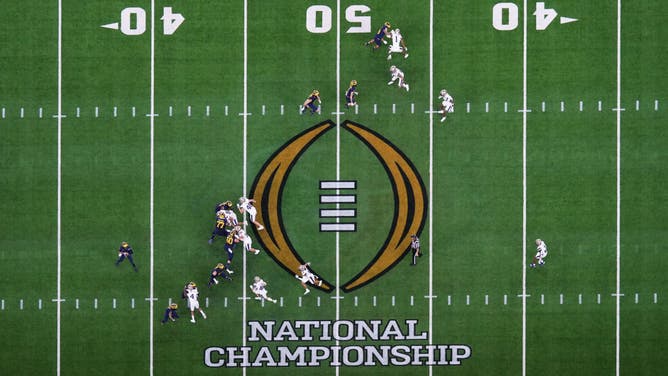College Football Playoff Format Have SEC And Big Ten Forcing Others To Bend The Knee? It's Getting Complicated
It's All About The Money For College Football, Obviously
Once again, the College Football Playoff is changing formats, starting in the 2025 season with ‘straight-seeding’ that should’ve been put into place when we moved to twelve teams. But, that's not the only adjustment coming in the near future that will have conferences like the ACC and Big 12 having to bend the knee.
As we had previously reported, there was a consensus to change how we arrived at the twelve teams participating in the postseason, and how they would be ranked following conference championship weekend. Last year, each power-four conference champion received an automatic bye in the playoff, which led to arguments being made inside the CFP meeting rooms.
Did Arizona State deserve to have an automatic bye last season? Well, that's up for argument. But the focus will now shift towards how the committee decides to rank the top-12 teams in college football.
For the 2025 season only, for now, whichever teams are ranked in the top four will receive an automatic bye in the first round. The conference champions will receive an automatic bid, but getting to wait for an opponent in the quarterfinals is now off the table.

HOUSTON, TEXAS - JANUARY 8: Michigan Wolverines quarterback J.J. McCarthy (9) drops back to pass during the national championship NCAA College Football Playoff game at NRG Stadium, Monday, Jan. 8, 2024, in Houston. (Elizabeth Conley/Houston Chronicle via Getty Images)
How Will This New Rankings System Look? Who Gets Automatic-Byes?
In short, the committee will rank their top-12 teams, and if you are ranked within the one through four, you get a bye. While the previous placement system only lasted one season, it caused enough commotion that the committee, along with commissioners from the ACC, Big 12, SEC, Big Ten, along with Notre Dame voted to change protocol.
And trust me, that doesn't mean Jim Phillips from the ACC or Brett Yormark from the Big 12 were happy about it. But, they used the lines ‘in the best interest of college football’ when discussing why they were on-board with the move.
While that sounds kosher, the biggest problem for those outside the SEC and Big Ten is that they no longer hold the power when it comes to what the future will look like regarding the playoff. When all parties signed a new agreement last year, it essentially gave Greg Sankey and Tony Petitti the power to determine what the future looks like. If you're wondering why they would do that, look no further than their payouts from the college football playoff, along with the television contract with ESPN.
And as you all know by now, this comes down to money. When, not if, the college football playoff moves to a bigger field in 2026, it will come with bigger payouts for each conference, with the SEC and Big Ten receiving a larger percentage.
A One-Year Bridge To Further Playoff Expansion In 2026
There will be changes after this upcoming season, so don't get too comfortable with twelve teams.
The bigger component is how many automatic bids each conference will get in the future. Right now, commissioners from the Big Ten and SEC are pushing the "4-4-2-2-1" model, which would give the two leading conferences four automatic bids each, while the ACC and Big 12 would receive two, with one bid going to the highest-ranked Group of Six conference member, and the other three at-large bids going to the whichever teams are ranked the highest.
This also includes Notre Dame, but only if the committee ranks them within the top sixteen.
Don't forget that when we do have a final playoff format voted on, the SEC will then move to a nine-game conference schedule, which the Big Ten is already competing with. So, there is a caveat to adding teams to the CFP for the SEC.
Having fun yet? As you can imagine, commissioners from the ACC and Big 12 want an additional bid, which would give them three teams each. But, that would decrease the number of at-large bids from three to one, which would cause further arguments from college football leaders not named Greg Sankey or Tony Petitti. But, this is what happens when you give into the pressure, and, unfortunately, the ACC and Big 12 might have to learn this the hard way. Unless they put up a massive fight.
Even then, the SEC and Big Ten still hold majority power, thanks to that contract signed last year.
As we also previously reported, the expansion could lead to a new conference championship weekend format. While it is written in their television contracts that the SEC and Big Ten must have a championship game that features their top two teams in the league, it could actually lead to an NCAA Tournament type play in games that would see four other teams battling for the two remaining automatic bids.
So, while we could see additional games, the obvious main component to adding more matchups is being able to sell these to ESPN, or FOX. Play-in games for conference bids and playoff spots? I can already hear the money being counted.
Do we need all of this? No. But, do you think with revenue sharing on the way that schools will turn down the opportunity to make some additional cash during the season? The answer is no.
Now that we are headed in a new direction with paying players, schools are willing to risk it all to make more money. In this case, we might be going a little overboard with these changes.